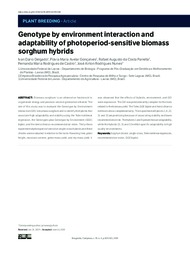Genotype by environment interaction and adaptability of photoperiod-sensitive biomass sorghum hybrids.
Genotype by environment interaction and adaptability of photoperiod-sensitive biomass sorghum hybrids.
Author(s): DELGADO, I. D.; GONÇALVES, F. M. A.; PARRELLA, R. A. da C.; CASTRO, F. M. R. de; NUNES, J. A. R.
Summary: Biomass sorghum is an alternative feedstock to cogenerate energy and produce second-generation ethanol. The aim of this study was to evaluate the Genotype by Environment Interaction (GEI) in biomass sorghum and to identify the hybrids that associate high adaptability and stability using the Toler nonlinear regression, the Genotypes plus Genotype by Environment (GGE) biplot, and the Annicchiarico recommendation index. Thirty-three experimental photoperiod-sensitive single-cross hybrids and three checks were evaluated in relation to the traits: flowering time, plant height, moisture content, green mass yield, and dry mass yield. It was observed that the effects of hybrids, environment, and GEI were expressive. The GEI was predominantly complex for the traits related to the biomass yield. The Toler, GGE biplot and Annicchiarico methods show complementarity. The experimental hybrids 1, 8, 22, 31 and 33 are promising because of associating stability and lower recommendation risk. The hybrids 1 and 8 present broad adaptability, while the hybrids 22, 31 and 33 exhibit specific adaptability to high quality environments.
Publication year: 2019
Types of publication: Journal article
Unit: Embrapa Maize & Sorghum
Keywords: Biomassa, Biplot GGE, Cruz simples, Regressão não linear de Toler, Sorgo
Observation
Some of Embrapa's publications are published as ePub files. To read them, use or download one of the following free software options to your computer or mobile device. Android: Google Play Books; IOS: iBooks; Windows and Linux: Calibre.
Access other publications
Access the Agricultural Research Database (BDPA) to consult Embrapa's full library collection and records.
Visit Embrapa Bookstore to purchase books and other publications sold by Embrapa.

